Since Richard Holland and Jonathan Harvey founded their London-based architecture firm Holland Harvey in 2012, they have made a name for themselves in food retail, restaurants and hospitality. But what really distinguishes their practice is the integration of a value-led approach to their work and a conscious decision to choose environmentally and socially sustainable paths where they can. Their emphasis on teamwork and collaboration is a welcome switch from “me, the architect” to “we, the team”.
SL: You call your architecture practice “value-led”, what does that mean? What are your values?
Richard Holland: The Covid-19 lockdowns inevitably led to a lot of self-reflection, and certainly to the conversations that Jon and I ended up having about who we are, what our interests are, what we’ve been doing for the past ten years and what we want to be doing for the next ten years and beyond. We had this amazing portfolio of projects. One of the common themes was food but we were also working in hospitality, we were working in housing and we were doing homeless shelters. We reflected on why have we done all these projects and found the strand that’s always been within our practice has been one of social impact.
We reflected on why have we done all these projects and found the strand that’s always been within our practice has been one of social impact.
Jonathan Harvey: The precursor to Holland Harvey was an organisation we formed called Free Architecture, which was attempting to be a bit of an alternative to the competition culture that exists within the profession by trying to redirect some of that energy towards pro bono architecture for third-sector clients and charities. Perhaps the name was a bit misleading because everyone just expected us to do their loft conversions for free. So it never really got off the ground but it morphed into Holland Harvey, and that was really the origin of the practice. I guess that idea about social impact, and the ability of design to make a positive social change has always been with us. Covid just gave us the opportunity to reflect on how that could be used to steer the rest of the work that we were pitching for at the time.
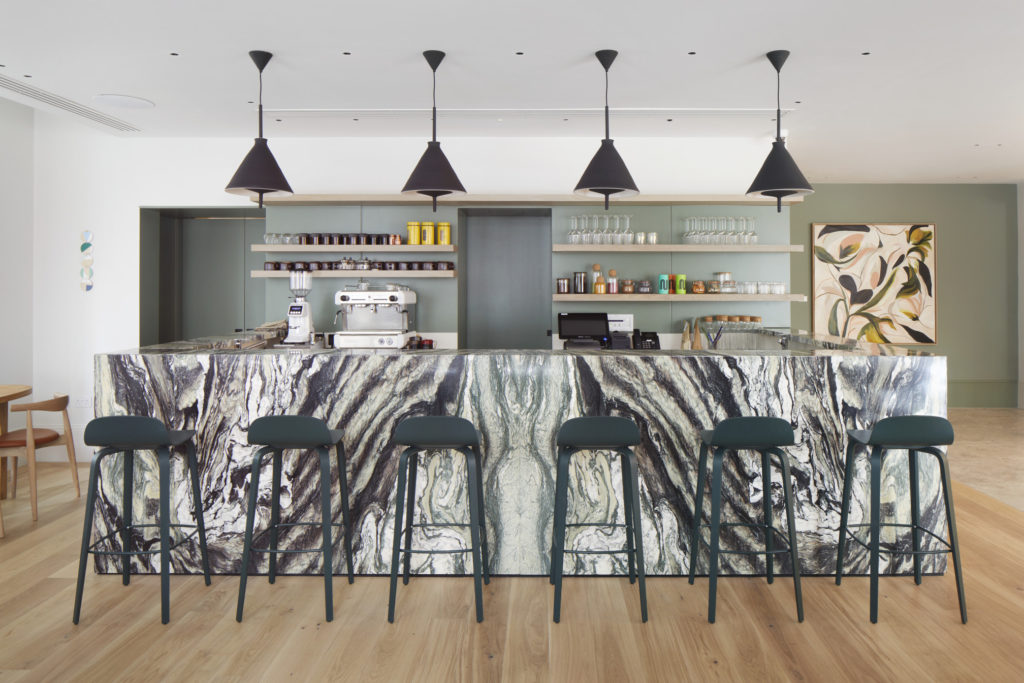
Sophie Lovell: You also say your “designs are a product of our values and our belief that design should make a positive social and environmental impact”. As with other industries, this involves a lot of trust on the part of the consumer and is really hard to police. How do you cut through the greenwashing veneer and really make sure you practise what you preach on a practical level?
RH: Well, around the same time, we were starting to notice the prevalence of B Corporation as a form of universal standard relating to social impact and, as an extension, environmental impact. So now we’re formally in their certification process.
Orlando Lovell: Can you explain what B Corporation is, for people that might not know?
RH: B Corporation was started in the United States. It is a certification standard that ensures for-profit businesses are meeting high standards of performance, transparency and accountability. I guess it answers your question about how you really have a positive environmental impact without it feeling like greenwashing: It’s very easy to say you’re doing those things, but unless you’re actually measuring your impact, how do you tell a good company from a bad company?
There is a quite rigorous evaluation and validation process for anyone applying for B Corp certification ranging from the governance of your company to the way that you treat your workers or your customers. Hopefully, at the end of it, they check all your policies, they check all your paperwork, they learn about your company, and then if you’re good to go, you get this certification, which essentially, is a rubber stamp across industries, not just architecture, because it’s a legal commitment to the highest standards of environmental and social impact.
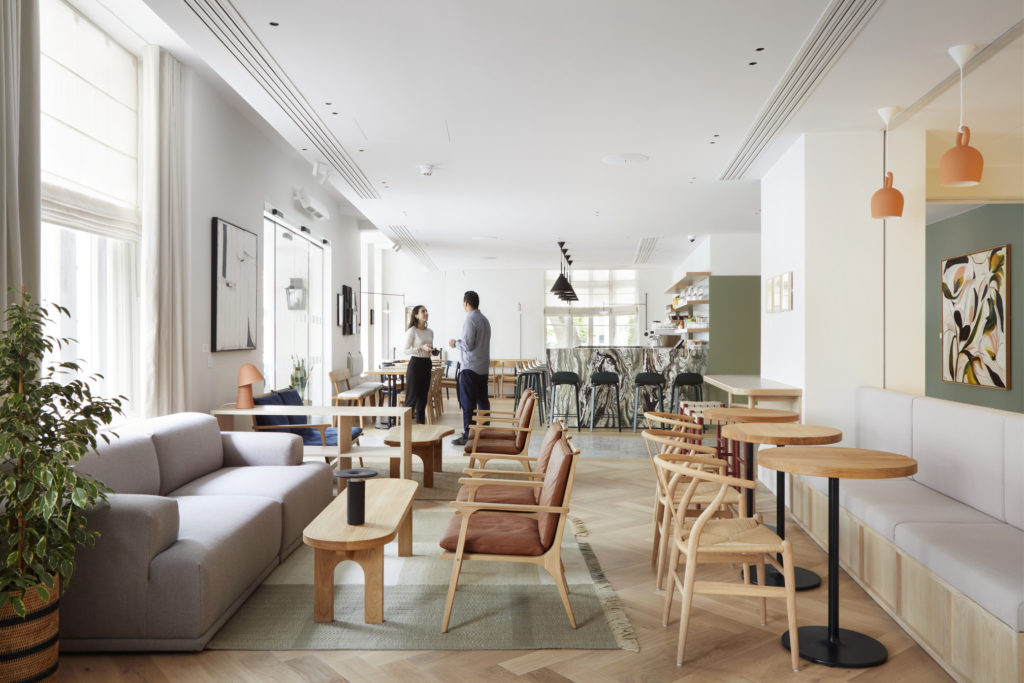
OL: Has it changed how you work?
RH: Yes. Within our practice, it’s creating this culture where, hopefully, the first question our team are asking when they’re specifying a product, or designing a space is: Am I doing this in the most environmentally conscious way? Or: Is there a way that I can embed some positive social impact into this decision that I’m about to make? Say I’m picking a tile for a bathroom for a hotel, am I going to specify one just because it’s cheap? Or am I going to actually do a bit more research to find an equivalent tile from somewhere else that’s 45 per cent recycled? So it’s become a primary decision-making tool as well.
JH: It gives you tools to help you get traction. These are things that we always thought we should be doing but it kind of helps you get over the line. Now everyone in the studio has at least one social or environmental goal as part of their review process. The way that we appraise the success of our team is now also based on whether they achieved those goals.
A lot of our work now is just growing our knowledge around products and materials.
RH: A lot of our work now is just growing our knowledge around products and materials. It can be a bit hard to find a product that has robustness, a tried-and-tested history, and hits the price point that some of our commercial clients need to hit. So you just have to have this constant r&d process, which is part of what we do now, every day as we expand our database.
JH: This research is not just about looking up a website, it’s finding the suppliers, meeting them, inviting them in to the office to talk about the project and so on. Recently, for example, our team came across a new material made from recycled coffee grounds that can be used to make table tops. We have one customer who roasts their own coffee and therefore have a huge amount of coffee waste and they’re like, “great, we can turn that food waste into our tables”.

OL: You said that one of your goals is social impact and that’s what your architecture office grew out of, but you have also done a lot of food-related projects. What is the bridge between social impact and food for you?
RH: The actual bridge was an organisation called Goldfinger, which is a social enterprise based in the Trellick Tower in London (a social housing high-rise project designed by architect Erno Goldfinger in the early 1970s). Their business model is about waste and circular economy in terms of joinery, so they take waste timber that’s been stripped out of the building sites or diseased trees from local authorities, or just recycled stuff and turn it into new furniture that they sell through their showroom.
They also have a programme where they work with disadvantaged youths from the local estate as well as a people’s kitchen – they basically run a soup kitchen on-site. All these elements work together. We have worked with them for a long time, whenever we’ve needed special pieces of joinery. Over the years they have become more sophisticated as an organisation and as our clients and projects have scaled up, we’ve kind of gone on that journey together. From planters for Gails’ bakery outlets to the Inhabit hotel and now they’re working with us on the new Tate Modern restaurant.

I guess that was our first sort of eureka moment, that through the decisions that we make as a practice, we can choose our supply chain and if that supply chain can be a social enterprise, then our work is inherently having a wider social impact. So even if it’s not us specifically creating the social impact, we are creating opportunities via our projects and through our clients.
I guess that was our first sort of eureka moment, that through the decisions that we make as a practice, we can choose our supply chain and if that supply chain can be a social enterprise, then our work is inherently having a wider social impact.
SL: Is food part of your own everyday studio practice? And if so, in which way?
JH: Definitely, yes. Every other Friday two different members of the team cook lunch for the office. there are 24 of us. We basically subsidise the lunch and then they all cook. We don’t really have a kitchen, we have two slow cookers, two microwaves and two kettles but it’s amazing the magic that people come up with!
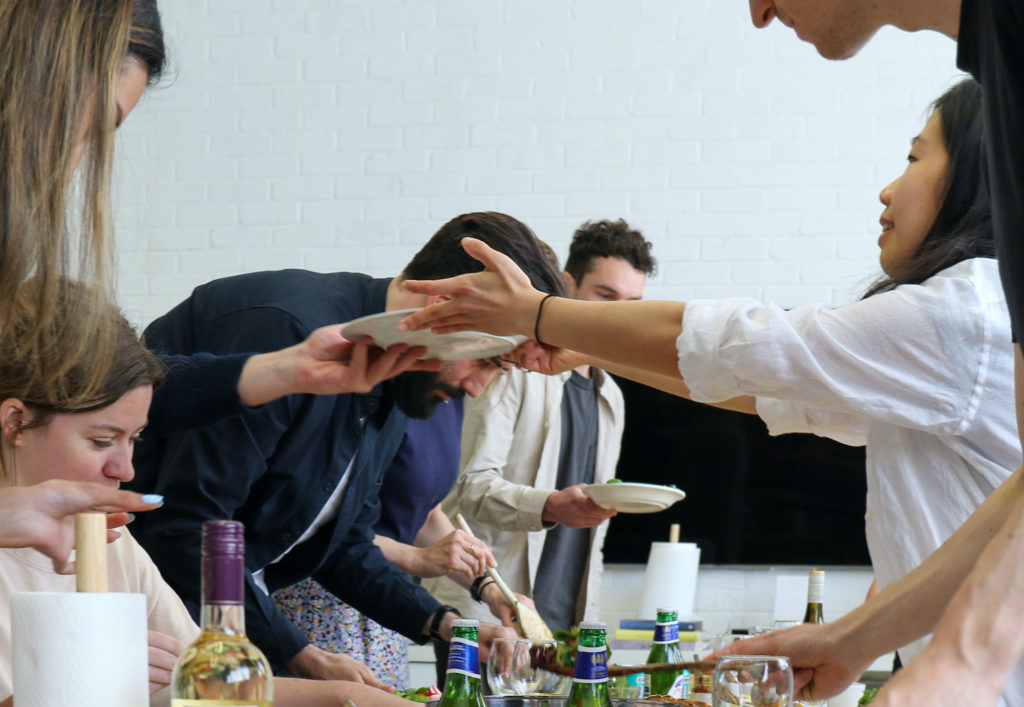
This fortnightly lunch is really important, particularly in the context of working from home. We operate a very flexible studio and only have one day of the week when we mandate people to come in. Eating together every other week, as a minimum is a really nice thing to get to do. It is the baseline: the time and place where we talk and communicate and be together. Beyond that, there is always food around what we do since a lot of our projects are to do with gastronomy. It’s important that we go visit our projects and spend time in them. As we speak, half the team are down having breakfast at Gail’s down in Spitalfields.
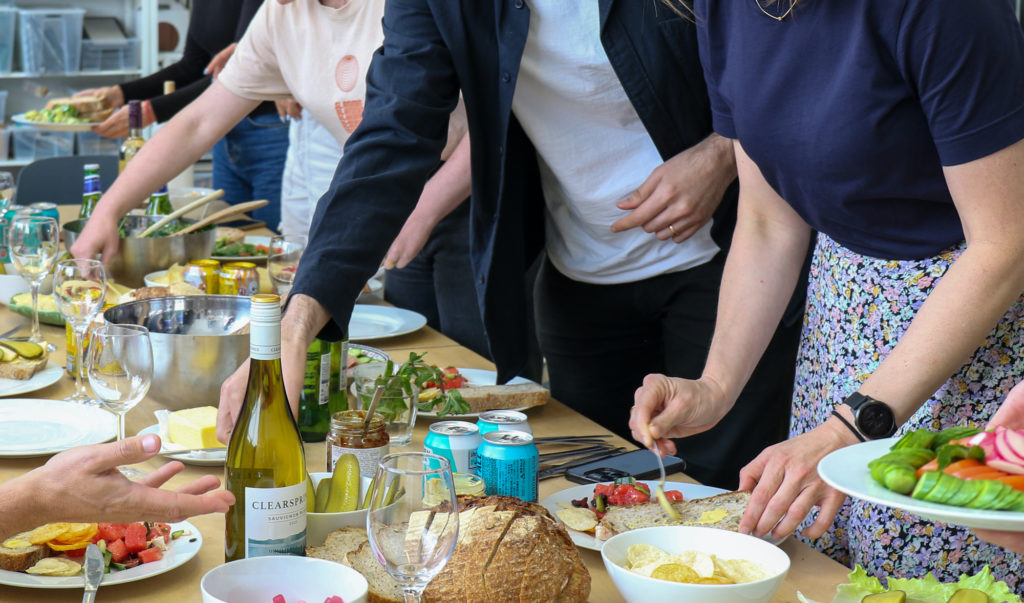
The social aspect of food is a vital part of our practice.
The social aspect of food is a vital part of our practise. Our 2019 design for a London homeless shelter (Shelter From the Storm) was all about the restorative aspect of eating together. It sounds cheesy but literally breaking bread together, is a really basic human thing. Becoming homeless strips away every part of your ego, you become a very raw version of yourself. The first thing that happens in this shelter is that you can come in and sit together with other people and eat, and talk. The whole thing was designed to centre around the kitchen where the volunteers cook. So they’re cooking, and you’re eating together in the same space.
We never really thought about why we wanted to eat meals together as a practice but then those ideas crystallised for us when we worked with this client who has spent years thinking about and doing it as a part of their process for helping the homeless. It seems to be a nice kind of alignment somehow.
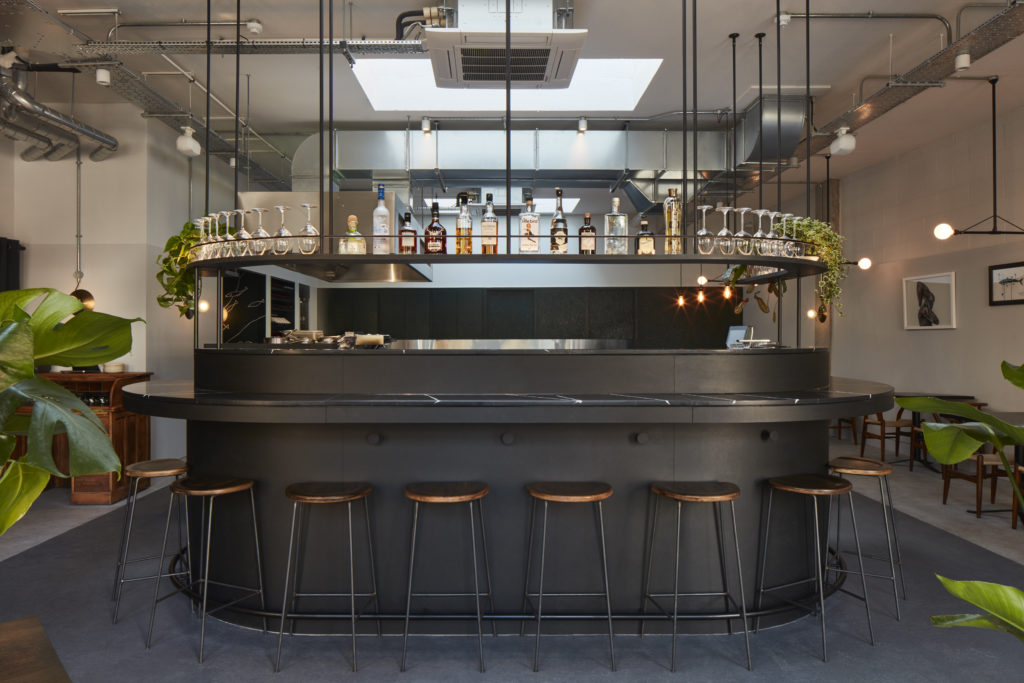
SL: Let me ask you about one of your current projects in progress: a brief from Tate Eats to redesign the Level 1 Cafe for the Tate Modern in London. As a cultural institution for the arts, they are interestingly very involved with food. Can you give a couple of examples in this case that show different ways they approach the theme of food?
RH: As a cultural institution, not only do the Tate make all their own food but they are very passionate about where their food comes from, and the narratives that are behind that. They did this lovely pop-up as part of Pride Week 2022, where they brewed a beer specifically for that event. And the same goes for coffee roasting. They have their own coffee roastery, where they roast all their own blends for all their F&B outlets at the back of Tate Britain, you’d never even know is there.
There is also a central production kitchen within the Tate Modern that produces all the food for all the Tate’s London spaces. It’s all freshly made every day in huge volumes and to a very high-quality standard. Part of the whole challenge for our design for the new cafe is how to communicate that in-depth approach, including this abundance of quality ingredients and food, through our space design.
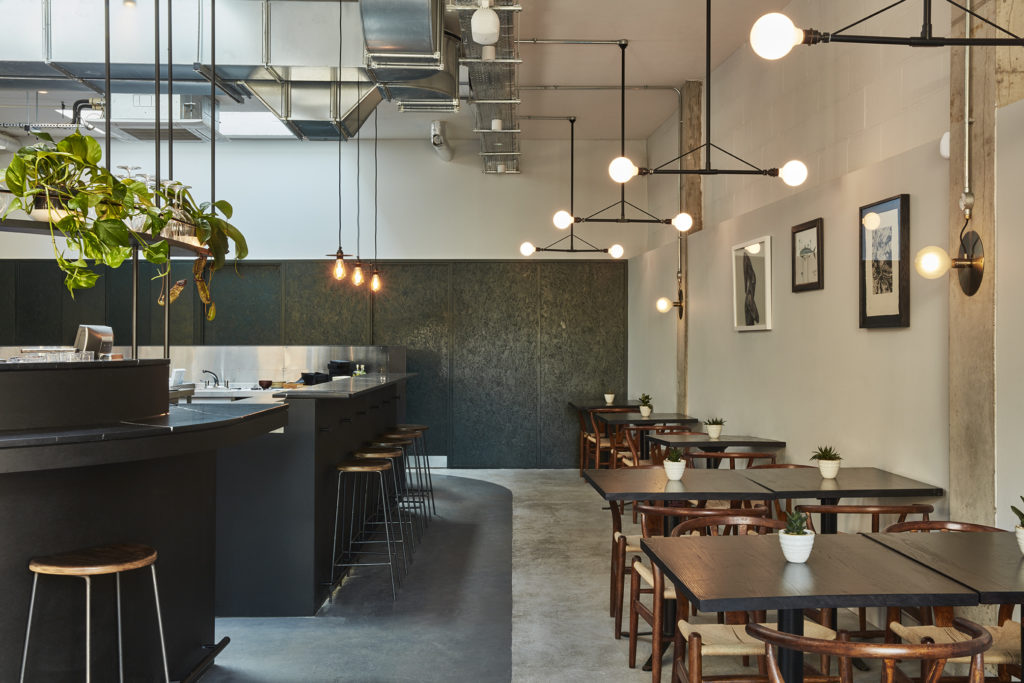
SL: When you have a very sophisticated, forward-thinking client such as Tate Eats, do you seek out other experts to work with for a client like this or do you rely on your own expertise?
RH: The way that we’ve developed our knowledge within the industry has always been in combination with lots of external people. It always starts with the client who is usually an expert in their field. Tom Brown is an amazing chef, for example, he knows exactly what he needs. And so our job when we designed his Cornerstone restaurant for him in 2019 was just to facilitate the expression of his expertise and to ensure we designed a space around him to give him the optimal environment to produce beautiful food.

Another example is Gail’s bakeries. We’ve worked with them for ten years. If you are designing a bakery kitchen, you need to understand the relationship between the oven and the prover, for example, or that if you open a door to an oven for longer than 30 seconds, the temperature drops too much and your chocolate is ruined.
JH: Sometimes there will be a food expert consultant involved but quite often it’s our job to facilitate the expertise of our client to come through into the design. One thing you’re trained to do as an architect is to be the lead consultant: you are the person who is coordinating the architectural vision, the structural design, the MEP strategy, the ambitions of the client, and so on. You are the person who’s bringing all of those influences together to deliver this space, this building or whatever it might be.
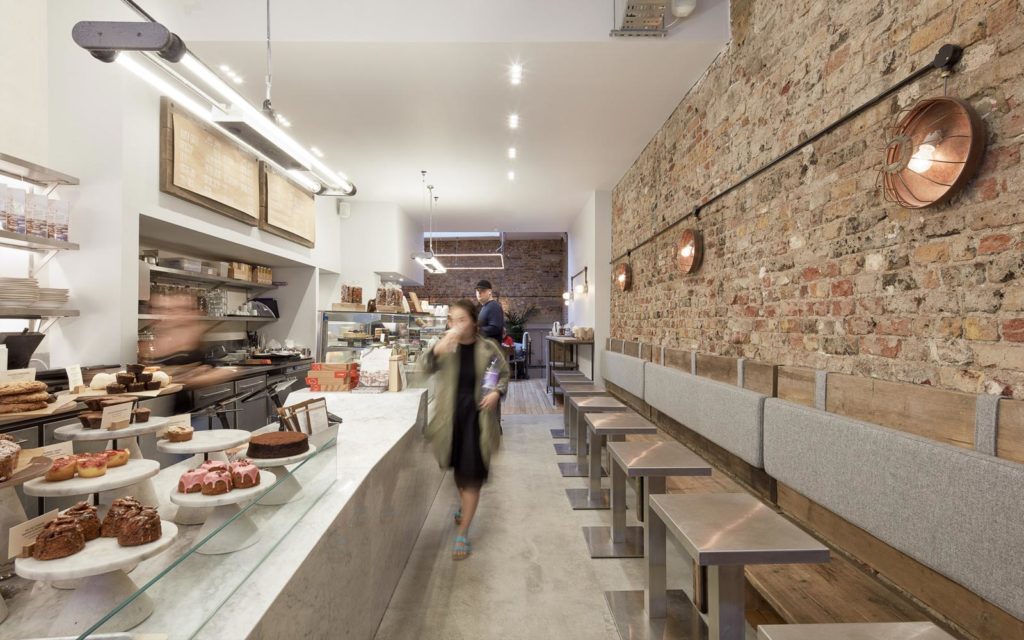
It’s the same in the context of the architecture of food or designing for food environments. There’s a client who has a vision. There’s normally an operations person who’s just concerned about customer flow and price points. You’ve got a kitchen supplier or designer who knows all the bits of kit and how they fit together. There’s typically a chef who has a vision for the product. And then there’s branding, marketing and customer experience. Our job is to listen to all those people, sit in big meetings and tie all those elements together, initially into a diagram that works for everyone. And then you’re just layering on the detail, the equipment, the materiality, the brand, the marketing, and then eventually it becomes a space.
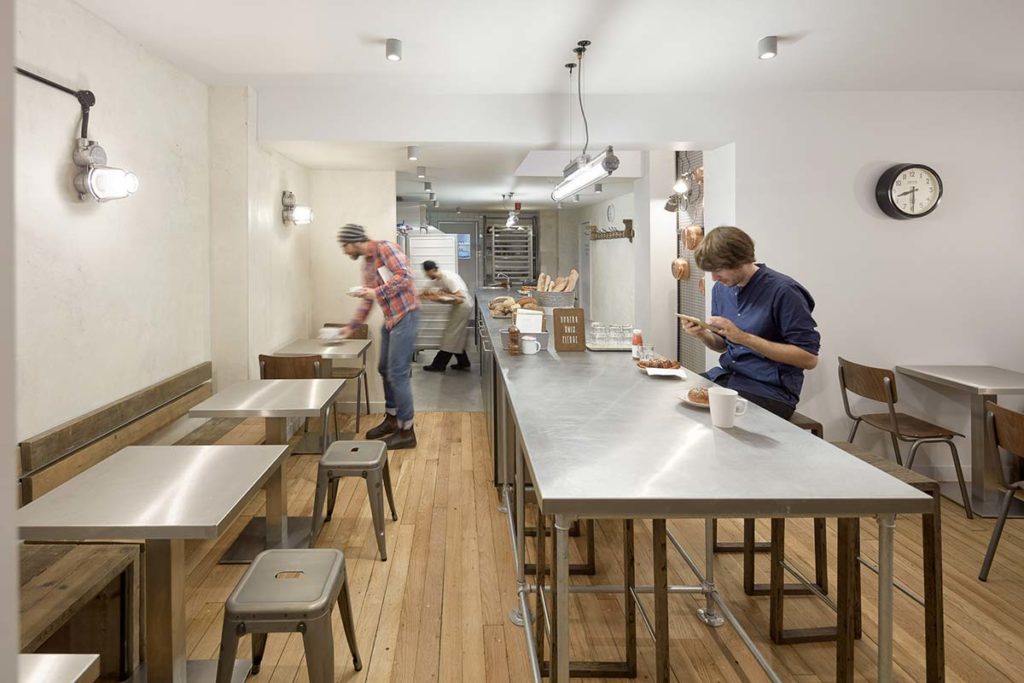
SL: So food retail is a whole lot more than just production line meets traffic?
RH: One thing with the food retail industry is that the parameters can change quickly. We have another client called Farmer J who have a fast, casual restaurant chain in the City of London. We met them in 2018, they had four sites already and were very convinced that this is what they were going to continue to do. But in the four years we’ve been working with them, the world has changed, the price of food has skyrocketed and so have energy costs. Their original concept needed revisiting as scalability was a challenge. So now we’re completely disassembling everything we thought we knew about what they did and redesigning the whole kitchen for them. I think this is vital for any restauranteur or food operator who is scaling to understand: that things are going to change, and you need to design in adaptability for that.
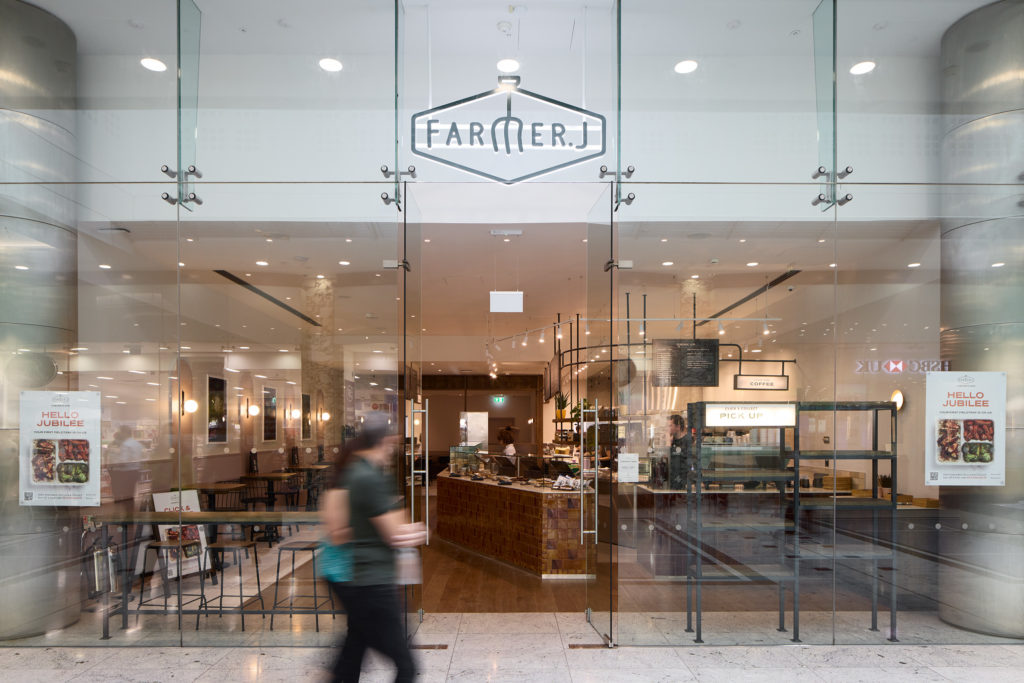
OL: From your answers, I think I’m also hearing that as well as your own team being very focused on r&d and this kind of integral process that you have in your own practice, you also look for clients to match – who are equally curious and conscious.
RH: In the past, when we pitched to a new client, we used to run through a picture book of projects and we could just see the client’s eyes glaze over by project four. But now we have turned it around and pitch our values instead; we pitch all the stuff we’ve been talking about here. And then we used the work to illustrate particular ideas or particular processes or particular points that we are making. If people buy into that sort of value-driven approach, they will usually end up working with us.
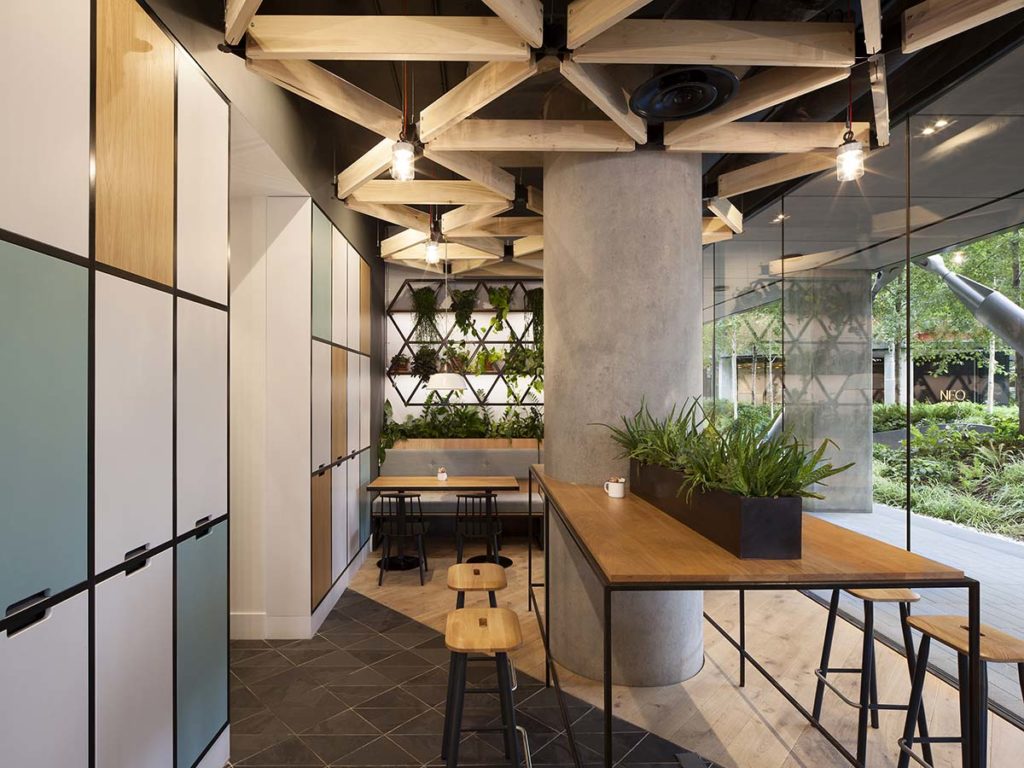
But similarly, because we’ve now got such a large portfolio of food and beverage projects, we do get approached by clients we don’t align with. Despite there being perhaps dark clouds on the economic horizon, we have really just got to a point where we don’t want to work with these people. They’re not right for us when we’re not right for them. It’s not Holland Harvey, it’s not what we do.
We’ve spent ten years raising the bar, we don’t want to start bringing it down now.
JH: And even if we did, how would we pitch this to our own team? These guys have joined us on the premise of working with amazing aspirational clients. If you then bring in one that’s subpar, you’re introducing a layer of mediocrity that just brings everything else down to it. We’ve spent ten years raising the bar, we don’t want to start bringing it down now.
OL: I think this is really a sign of the times, people are feeling this sense of urgency or change and don’t want to waste their time with something that doesn’t align.
JH: There is that. I mean, we’ve had difficult clients in the past, and I’m not going to pretend for a moment that every single one of our clients, historically, has been perfectly aligned. But you know, you learn and you evolve and you mature. And then you get to a point when you can say “no” and that is an amazing feeling of empowerment.
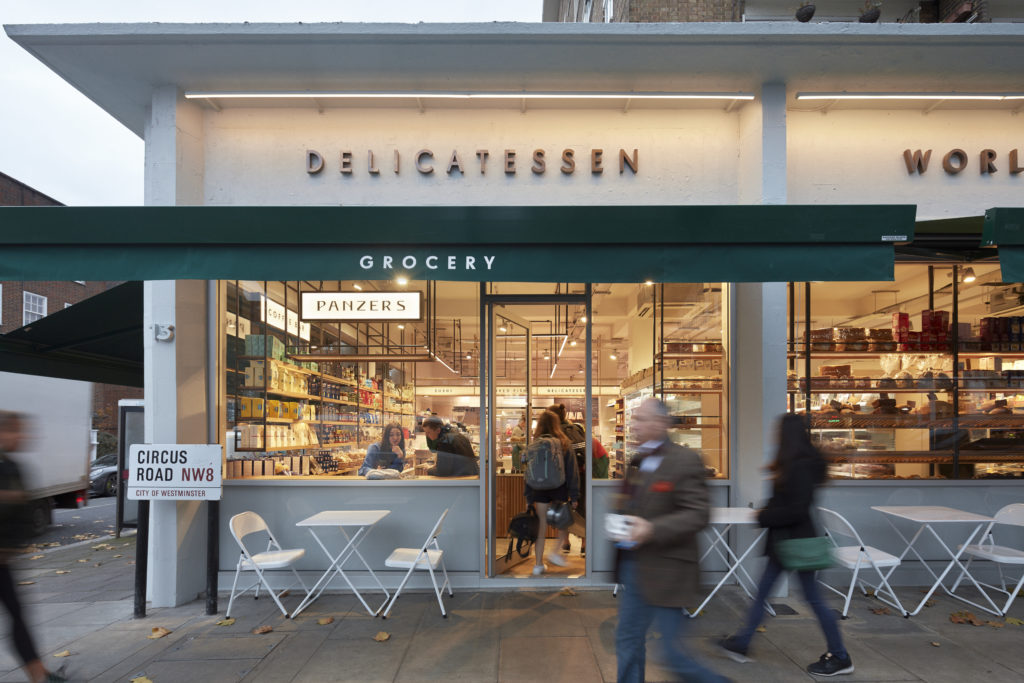
Another thing that working like this gives you is a network of companies that think in the same way as you. if we want to buy cleaning products for the office, for example, our studio assistant will go and seek out B Corp, cleaning products. And hopefully further down the line, when we are B Corp registered, a major B Corp client will be looking for a new office and they’ll look for a B Corp architect to design it for them. It has a sort of vetting process baked into it and I think that’s quite nice.
Another thing that working like this gives you is a network of companies that think in the same way as you.
RH: We’ve always been interested in working this way and we’ve always done it. In fact, we have recently realised that we perhaps need to talk more about our values because some of our clients are saying “Oh, I didn’t know as you guys did that”. And we say: “You do realise that all those tables and all that all those tiles, all that thing that you’ve had specified in your project and we never really talked about were all more sustainable or came from social engagement products?” Sometimes a client may not be directly engaged (in social and environmental sustainability). But that doesn’t stop us still specifying that way. At the end of the day, there’s a cost plan with 1,500 different prices. If the numbers at the bottom are ok then that is what matters with some clients. Whereas perhaps if you told them explicitly something was a sustainable product they would assume it’s expensive and strike it out. So for these clients, it’s a case of: “We’ve already been doing it, we just didn’t really tell you about it.” Sustainability by stealth.
JH: Going back to greenwashing, it shouldn’t just be a little footnote that we’re committed to this. A lot of people use environmentally-conscious practices as their USP but it shouldn’t be. Sustainability is not a trend, it should be a baseline. We were taught this at university 20 years ago, but now it’s become a trend because brands are aware that if they’re not engaging with these issues, they’re going to fail.
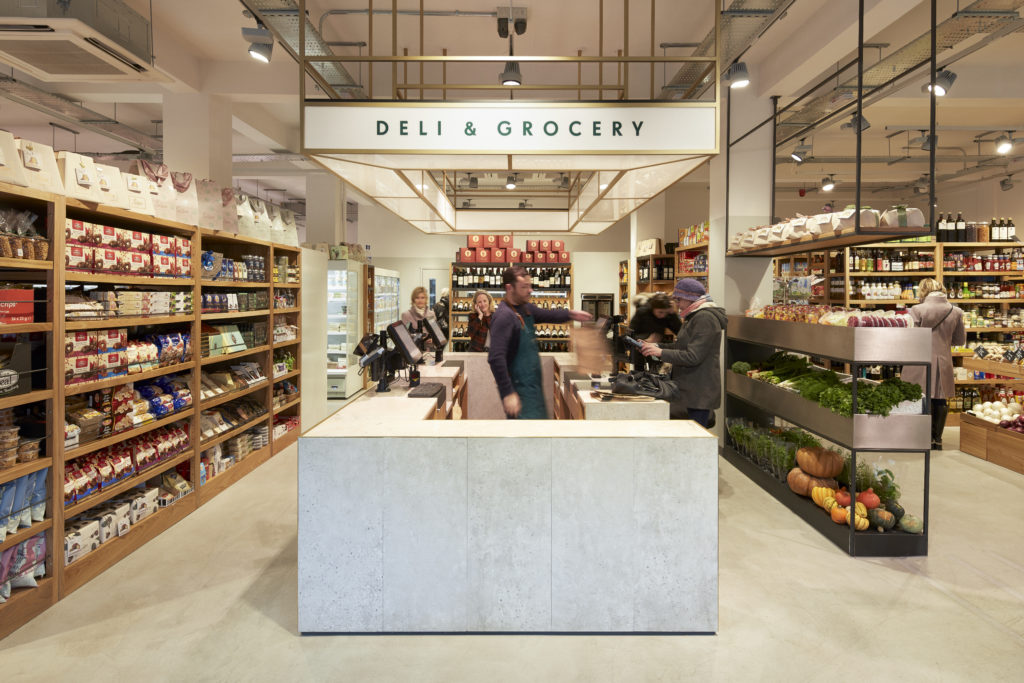
RH: We also have lots of projects where sustainable products for a particular specification don’t yet exist and we then have to default to the standards. It’s just about finding opportunities where you can. With our Inhabit hotel, which opened this year in Bayswater, for example, we asked ourselves the question: “What are we specifying the most here?” And the answer was carpet, and tiles, they were 95 per cent of the project. So if we can get those things, right, and make sure our carpets are made from recycled fishing nets, and the tiles are coming from recycled clay, then that is brilliant. The last five per cent is a little trickier. We just have to accept that just maybe in 20 years’ time we’ll be able to get it 99 per cent perfect, but the market isn’t quite there yet. In the end, it’s just about doing what you can do, talking about the things that you’ve done, and then seeking out the bit that you’re missing. You’re always aspiring towards something, but you know, no one’s there yet. No one’s perfect.
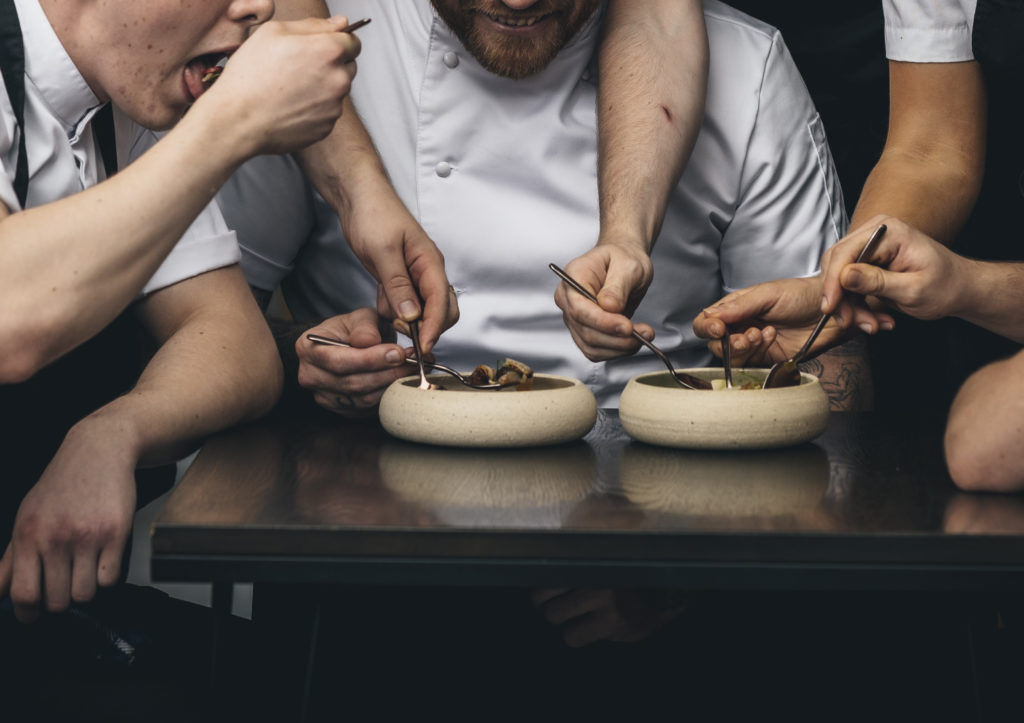
SL: But that’s a problem when you’ve got clients and a consuming public on an opinion scale that goes from “I don’t give a damn” to vegan and beyond. Doing the best we can, even if it’s not perfect, clearly needs to be the default but as long as there is still this extreme pluralism of values is it really enough?
OL: I think the default is more interesting for me if it involves constantly looking for those opportunities as you describe. I think this kind of questioning process is what should be the default.
RH: There are just so many contradictions, that’s the problem. We were talking recently in the studio, about using leather for the bench seats in the new Tate Modern restaurant, for example.
Leather is obviously a product that comes from animals. So immediately, if you use it, you’re potentially going to upset one community. But if you switch to non-animal leather, then it’s an artificial product which could be made from hydrocarbons, which means oil and that’s going to upset another community. Then there are all sorts of other alternatives such as leather-like material made from banana skins or pineapple fibres but they’re pretty untested in the commercial context. We’ve got two million people a year coming through this place. If we go for the pineapple leather, which might look great on day one, but may have to be replaced every six months because it wears out, maybe it might have been better to have used animal leather in the first place and just accept that you’re going to upset that group.
You have to think about all these issues in the round all the time, because there’s no perfect answer.
You have to think about all these issues in the round all the time, because, to your point, there’s no perfect answer. You’re going to piss off somebody or other. The added danger is that if you get on your soapbox too much, and you spin how great you’re being, you just bring all the weirdos out of the woodwork. So you just kind of have to make the best judgment that you can and the best decisions you can and roll with it.
Holland Harvey is an architecture and interior design studio founded by Richard Holland and Jonathan Harvey in 2014 that has grown into a community of interdependent designers. They are based in East London.
Sophie & Orlando Lovell are a mother-and-daughter team working together as studio_lovell. They are the co-founders of The Common Table.
Title photo (detail) © Lateef Okunnu, courtesy Holland Harvey.






